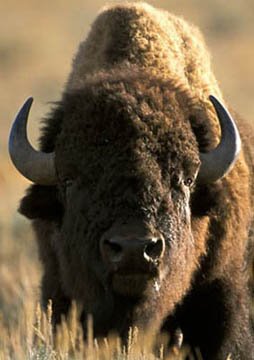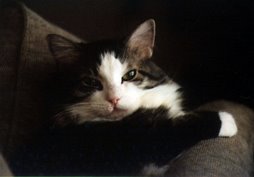While delving into the dusty history of buffalo in Champaign County, I came across a journal entry written in June 1673 by Jacques Marquette, the French missionary who was canoeing down the Mississippi River with a party of explorers near the present-day Quad Cities area of western Illinois. A mostly unexplored part of the Louisiana Territory, the land that is now Illinois contained many buffalo. Marquette wrote of the buffalo, an exotic sight for a European:
"We shot one of them, and it was as much as thirteen men could do to drag him from the place where he fell. They have an enormous head, their forehead is broad and flat, and their horns, between which there is at least a foot and a half distance, are all black and much longer than our European oxen. They have a hump on the back, and their head, breast, and a part of the shoulders are covered with long hair. They have in the middle of their forehead an ugly tuft of long hair, which, falling down over their eyes, blinds them in a manner, and makes them look hideous. The rest of the body is covered with curled hair, or rather wool like our sheep, but much thicker and stronger. They shed their hair in summer, and their skin is as soft as velvet, leaving nothing but a short down. The Indians use their skins for cloaks, which they paint with figures of several colors! Their flesh and fat is excellent, and the best dish of the Indians, who kill a great many of them. They are very fierce and dangerous, and if they can hook a man with their horns, they toss him up and then tread upon him. The Indians hide themselves when they shoot at them, otherwise they would be in great danger of losing their lives. They follow them at great distances till, by loss of blood, they are unable to hurt or defend themselves. They graze upon the banks of rivers, and I have seen four hundred in a herd together."
Friday, January 30, 2009
Buffalo in Illinois, 1673: "I Have Seen Four Hundred in a Herd"
Friday, January 23, 2009
Did Buffalo Swim the Sangamon? A Dive into History
 In the 1600s the French explorers LaSalle, Jolliet, Marquette, Xavier, Charlevoix and others roamed what is now Illinois and saw plenty of buffalo, sometimes as many as 500-600 in a herd. Their letters and journals document this. Unfortunately, buffalo had disappeared from Illinois by 1830. I've been doing some research on buffaloes in central Illinois, specifically right around here in Champaign County. Historical records point to three distinct buffalo traces, or wide paths, created long ago by large numbers of the slow moving giants. It's going to take some detective work, but I want to shed some light on these traces that stretched from the Champaign area to the Sangamon River and the Mahomet area, then northwest toward Bloomington and beyond. I'll keep y'all posted on what I find.
In the 1600s the French explorers LaSalle, Jolliet, Marquette, Xavier, Charlevoix and others roamed what is now Illinois and saw plenty of buffalo, sometimes as many as 500-600 in a herd. Their letters and journals document this. Unfortunately, buffalo had disappeared from Illinois by 1830. I've been doing some research on buffaloes in central Illinois, specifically right around here in Champaign County. Historical records point to three distinct buffalo traces, or wide paths, created long ago by large numbers of the slow moving giants. It's going to take some detective work, but I want to shed some light on these traces that stretched from the Champaign area to the Sangamon River and the Mahomet area, then northwest toward Bloomington and beyond. I'll keep y'all posted on what I find.
Tuesday, January 20, 2009
Tuesday, January 13, 2009
An Unlikely Friend of the Buffalo
Got an e-mail this morning from one of the Buffalo Allies of Bozeman, Montana, with a link to information about Jarid Manos. I had never heard of Jarid but instantly I became interested when I read the following he had written in response to an article on the Scientific American magazine website about the slaughter of buffalo at Yellowstone National Park:
"The buffalo have suffered so much yet the last wild herd left in the Yellowstone area are being blamed and killed for a cattle disease that came with ranchers' European cattle and the conquest of the West. Buffalo are not relics of the past; they are living, breathing survivors of a catastrophic violence that has turned the Great Plains --- the Garden of Eden that once was America's prairies and plains-- into a beaten, struggling, overgrazed death zone. America publicly prides itself on concepts of fairness and decency, yet until we as a nation move past our pathological violence against the Earth, each other, and ourselves, we will never evolve, and in fact likely find that same death and misery ultimately catching up to us too in the end. By healing the Earth, we can heal ourselves, and that is our our crucible and sacrament in the new millennium, embodied in our stricken Great Plains like no other."
Jarid Manos
Author/Ghetto Plainsman www.ghettoplainsman.com
Founder/CEO
Great Plains Restoration Council www.gprc.org
His book is now on my must-read list. Click on the links above to read more about Jarid. Remarkable story.
Friday, January 09, 2009
Christmas Leftovers
 Little Bull, busy here with a game, sits next to a new companion he received on Christmas morning. I wonder who gave him the little buffalo?
Little Bull, busy here with a game, sits next to a new companion he received on Christmas morning. I wonder who gave him the little buffalo? Red Chief, in upper center of photo, plays his part at his school's Chistmas program, which was presented today because an ice storm closed the school, canceling the program the last day before Christmas vacation.
Red Chief, in upper center of photo, plays his part at his school's Chistmas program, which was presented today because an ice storm closed the school, canceling the program the last day before Christmas vacation.Wednesday, January 07, 2009
Subscribe to:
Comments (Atom)













